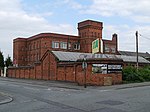Tetley Walker F.C.
1973 establishments in England2001 disestablishments in EnglandAssociation football clubs disestablished in 2001Association football clubs established in 1973Defunct football clubs in Cheshire ... and 4 more
Defunct football clubs in EnglandNorth West Counties Football League clubsSport in WarringtonWorks association football teams in England
Tetley Walker F.C. was a football club based in Warrington, England. The club started in the local Warrington leagues before making the step up to the North West Counties Football League. The club had a successful seven seasons in the NWCFL Division Two, winning the NWCFL Division Two league cup, reaching the Fourth Round of the FA Vase and finishing runners-up in the league, before folding in 2001 due to being evicted from their home ground, Long Lane.
Excerpt from the Wikipedia article Tetley Walker F.C. (License: CC BY-SA 3.0, Authors).Tetley Walker F.C.
Cossack Avenue,
Geographical coordinates (GPS) Address Nearby Places Show on map
Geographical coordinates (GPS)
| Latitude | Longitude |
|---|---|
| N 53.40911 ° | E -2.5874 ° |
Address
Cossack Avenue
WA2 9PB , Orford
England, United Kingdom
Open on Google Maps




